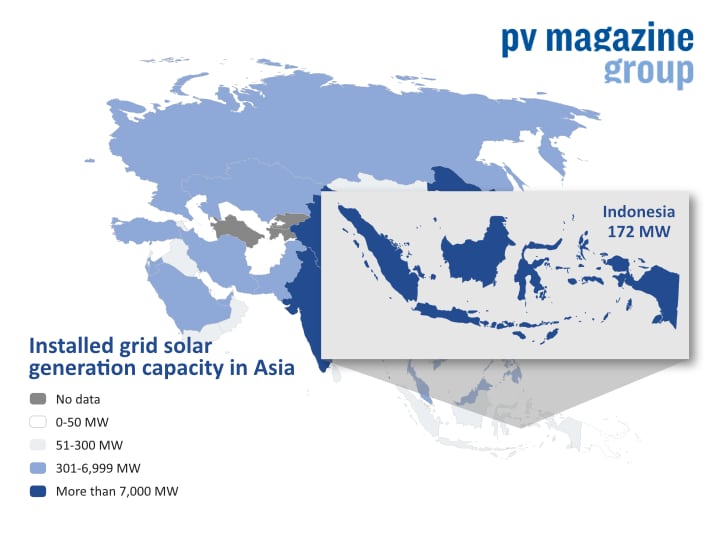A study prepared by the governments of Indonesia and Denmark has suggested a series of regional solar capacity targets can help the South East Asian nation to emission reduction targets which include having renewables supply 23% of its power mix by 2025.
The Renewable Energy Pipeline proposed by Indonesia's Department for Renewable Energy and Energy Conservation (Energi Baru Terbarukan dan Konservasi Energi) and the Danish Energy Agency has called for 2,379 MW of solar generation capacity to be added next year, as part of 6,713 MW of new projects by 2025, and 14,867 MW by 2030.
Far from being over-ambitious, the authors of the document stated developers have already committed to around 2.82 GW of new solar by 2025, and 7.87 GW this decade.
pv magazine print edition
Pick up your copy of the September edition of pv magazine today for a detailed update on solar and battery storage in the United States, which faces a tough decision between taking advantage of Asian imports, or developing domestic manufacturing at the risk of slowing progress towards decarbonization.
With Indonesian solar tenders having recently established prices of around $0.04/kWh, and expected to hit $0.037 in the next round of awards, the report's authors estimated new solar farms will be competitive against legacy coal plants in 2023.
Similar cost calculations, however, prompted the authors of the study to discount widespread deployment of solar-plus-storage projects at this stage as the price of energy storage tech would reduce competitiveness. The document states the Indonesian grid can cope with the scale of intermittent renewables planned in the strategy without the need for energy storage at this point.
The regional plan considers five renewable energy technologies, although it acknowledges the risk associated with the suggested dominance of geothermal – alongside hydro – in many regions, given the uncertain nature of the costs and lead times associated with the former. Discounting geothermal would require another 7 GW of solar by 2025, the study stated, for 13.7 GW of new photovoltaic capacity by that stage.
Popular content
Although the largest volume of new generation capacity is envisaged in the Java-Bali region – 1,058 MW next year, 3,298 MW by 2025, and 6,738 MW by 2030 – solar would supply only 1.8% of the renewable electricity needed in that zone to keep Indonesia on track with its clean energy targets.
PV modules would generate around 2% of the clean power needed nationally under the proposed regional plan and the solar contribution would amount to 4.5% in Nusa Tenggara, achieved by adding 131 MW of generation capacity next year, 161 MW by 2025, and 511 MW this decade. Some 401 MW of solar in Kalimantan next year, as part of 924 MW in four years' time, and 2,504 MW by 2030, would see photovoltaics supply 3.7% of that region's clean electricity.
Papua
Just 15 MW of panels in Papua next year, as part of subsequent totals of 75 MW and 255 MW of new solar, would see PV generate 2.5% of that region's clean electricity, and Sulawesi would rely on solar for 2.3% of its renewable energy, thanks to 279 MW next year, as part of 2025 and 2030 numbers of 729 MW and 1,629 MW, respectively.
Solar's smallest contribution is suggested in Maluku, which would require just 25 MW of project capacity next year, towards 55 MW in 2025, and 155 MW in 2030.
In terms of already planned capacity, Java-Bali has the highest figure, with solar developers having announced 4,195 MW of opportunities. The next highest figure is the 943 MW of solar projects planned in Sumatra. The latter region is earmarked to have the next largest volumes of solar added after Java-Bali, under the regional proposal, with 471 MW required next year, as part of 1,471 MW by 2025, and 3,075 MW by 2030.
This content is protected by copyright and may not be reused. If you want to cooperate with us and would like to reuse some of our content, please contact: editors@pv-magazine.com.



3 comments
By submitting this form you agree to pv magazine using your data for the purposes of publishing your comment.
Your personal data will only be disclosed or otherwise transmitted to third parties for the purposes of spam filtering or if this is necessary for technical maintenance of the website. Any other transfer to third parties will not take place unless this is justified on the basis of applicable data protection regulations or if pv magazine is legally obliged to do so.
You may revoke this consent at any time with effect for the future, in which case your personal data will be deleted immediately. Otherwise, your data will be deleted if pv magazine has processed your request or the purpose of data storage is fulfilled.
Further information on data privacy can be found in our Data Protection Policy.